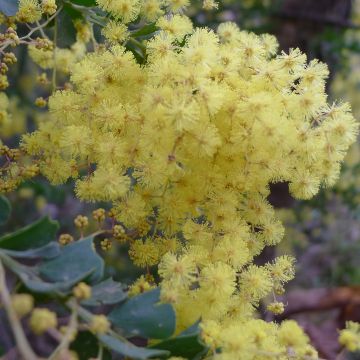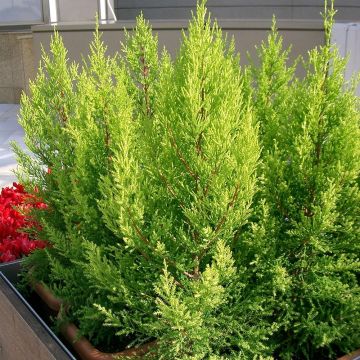

Acacia baileyana - Mimosa de Bailey


Acacia baileyana - Mimosa de Bailey


Acacia baileyana - Mimosa de Bailey


Acacia baileyana - Mimosa de Bailey


Acacia baileyana - Mimosa de Bailey
Acacia baileyana
Acacia baileyana
Cootamundra Wattle
Special offer!
Receive a €20 voucher for any order over €90 (excluding delivery costs, credit notes, and plastic-free options)!
1- Add your favorite plants to your cart.
2- Once you have reached €90, confirm your order (you can even choose the delivery date!).
3- As soon as your order is shipped, you will receive an email containing your voucher code, valid for 3 months (90 days).
Your voucher is unique and can only be used once, for any order with a minimum value of €20, excluding delivery costs.
Can be combined with other current offers, non-divisible and non-refundable.
Why not try an alternative variety in stock?
View all →This plant carries a 24 months recovery warranty
More information
We guarantee the quality of our plants for a full growing cycle, and will replace at our expense any plant that fails to recover under normal climatic and planting conditions.
Would this plant suit my garden?
Set up your Plantfit profile →
Description
The Acacia baileyana, also known as Bailey's Mimosa, is an Australian species relatively unknown among gardeners despite its exceptional ornamental qualities, easy cultivation, and good cold resistance, down to -8°C. It is a small evergreen tree with long flexible branches adorned with finely cut blue-grey foliage. Its bright yellow flowering is abundant in late winter or early spring. The shrub adapts to mediocre soils, tolerates drought well, and does not sucker. A true star in the garden or on the terrace!
The mimosas should not be confused with the tree we call acacia, which belongs to the botanical genus Robinia. They belong to the fabaceae family, just like alfalfa and lupins. The Acacia baileyana is a shrub native to Tasmania and Australia, specifically the southern part of New South Wales. It is most often grafted onto Acacia rootstock (the four seasons mimosa) which has the advantage of not suckering and allows for cultivation in limestone and very dry soils. When grown on its own roots, this mimosa dislikes excessive limestone. With a supple, rounded habit carried by long slightly drooping branches, it reaches about 4m (13 in 1 ft) in all directions at maturity. Its growth is rapid, already exceeding 2m (6 in 7 ft) in height at 2 years, in a Mediterranean climate. Its lifespan is about 10 to 15 years. The bark is the same blue-grey tone as the mature foliage. The numerous flower buds appear from late summer on the branches. Flowering occurs from January to March depending on the climate and weather conditions, and lasts about 3 weeks. The small round flowers are bright yellow and grouped in clusters in the axils of the leaves located towards the tips of the branches. Their scent is light, more noticeable during the hottest hours of the day. The foliage of Bailey's mimosa consists of small finely cut leaves with tiny blue-grey leaflets. The shrub itself can withstand short freezes around -8/-10°C (17.6 - 14°F), but the less hardy rootstock will perish below -5°C (23°F) if not protected. Since the root system is quite shallow, it is advisable to plant this mimosa in a sheltered location away from strong winds.
When planted in the ground in mild climates, Bailey's Mimosa can be placed as a solitary specimen, sheltered from strong winds, or in a shrub bed. It can be paired with other tender shrubs with an exotic appearance, such as Caesalpinia gilliesii, Sesbania punicea, escallonias, or even evergreen ceanothus. It can be grown in a pot and protected from winter frosts in a minimally heated greenhouse or conservatory.
Report an error about the product description
Acacia baileyana in pictures




Plant habit
Flowering
Foliage
Botanical data
Acacia
baileyana
Fabaceae
Cootamundra Wattle
Australia
Other Acacia - Wattle
View all →Planting and care
Acacia baileyana is best planted in March or April, in a very sunny position, sheltered from strong winds; autumn planting is reserved for mild regions. As the roots of the mimosa are shallow, it is advisable to install a stake at the time of planting to keep it upright and allow it to root. This bush is not demanding on the nature of the soil, but it must be sufficiently draining. As it tolerates drought once established, watering is not necessary when grown in open ground. Light pruning is recommended, especially if the tree is slightly exposed to the wind: after flowering, in December, shorten the branches that have bloomed by about half their length. This operation prevents the formation of seeds that unnecessarily exhaust the plant. Spring pruning can also be carried out to remove branches that have suffered from the cold and rebalance the habit of the bush. The mimosa is sensitive to cold; as soon as the temperatures approach 0°C (32 °F), it is advisable to install a thick mulch at its base to protect the graft and roots, and to cover it with fleece.
In the case of pot cultivation, repot in spring every two years in a large container. Water occasionally as the root ball should not completely dry out. In cold regions, it will be best overwintered in a bright and cool, but frost-free, room.
The pests of mimosa are the psyllid (false aphid) as well as the mealybug (Metcalfa pruinosa) and the Australian cochineal (Icerya purchasi), which are white, fluffy and cottony, with the latter two insects being more specific to the south. To limit their development, spray nettle extraction or diluted black soap at 5%.
Planting period
Intended location
Care
This item has not been reviewed yet - be the first to leave a review about it.
Similar products
Haven't found what you were looking for?
Hardiness is the lowest winter temperature a plant can endure without suffering serious damage or even dying. However, hardiness is affected by location (a sheltered area, such as a patio), protection (winter cover) and soil type (hardiness is improved by well-drained soil).

Photo Sharing Terms & Conditions
In order to encourage gardeners to interact and share their experiences, Promesse de fleurs offers various media enabling content to be uploaded onto its Site - in particular via the ‘Photo sharing’ module.
The User agrees to refrain from:
- Posting any content that is illegal, prejudicial, insulting, racist, inciteful to hatred, revisionist, contrary to public decency, that infringes on privacy or on the privacy rights of third parties, in particular the publicity rights of persons and goods, intellectual property rights, or the right to privacy.
- Submitting content on behalf of a third party;
- Impersonate the identity of a third party and/or publish any personal information about a third party;
In general, the User undertakes to refrain from any unethical behaviour.
All Content (in particular text, comments, files, images, photos, videos, creative works, etc.), which may be subject to property or intellectual property rights, image or other private rights, shall remain the property of the User, subject to the limited rights granted by the terms of the licence granted by Promesse de fleurs as stated below. Users are at liberty to publish or not to publish such Content on the Site, notably via the ‘Photo Sharing’ facility, and accept that this Content shall be made public and freely accessible, notably on the Internet.
Users further acknowledge, undertake to have ,and guarantee that they hold all necessary rights and permissions to publish such material on the Site, in particular with regard to the legislation in force pertaining to any privacy, property, intellectual property, image, or contractual rights, or rights of any other nature. By publishing such Content on the Site, Users acknowledge accepting full liability as publishers of the Content within the meaning of the law, and grant Promesse de fleurs, free of charge, an inclusive, worldwide licence for the said Content for the entire duration of its publication, including all reproduction, representation, up/downloading, displaying, performing, transmission, and storage rights.
Users also grant permission for their name to be linked to the Content and accept that this link may not always be made available.
By engaging in posting material, Users consent to their Content becoming automatically accessible on the Internet, in particular on other sites and/or blogs and/or web pages of the Promesse de fleurs site, including in particular social pages and the Promesse de fleurs catalogue.
Users may secure the removal of entrusted content free of charge by issuing a simple request via our contact form.
The flowering period indicated on our website applies to countries and regions located in USDA zone 8 (France, the United Kingdom, Ireland, the Netherlands, etc.)
It will vary according to where you live:
- In zones 9 to 10 (Italy, Spain, Greece, etc.), flowering will occur about 2 to 4 weeks earlier.
- In zones 6 to 7 (Germany, Poland, Slovenia, and lower mountainous regions), flowering will be delayed by 2 to 3 weeks.
- In zone 5 (Central Europe, Scandinavia), blooming will be delayed by 3 to 5 weeks.
In temperate climates, pruning of spring-flowering shrubs (forsythia, spireas, etc.) should be done just after flowering.
Pruning of summer-flowering shrubs (Indian Lilac, Perovskia, etc.) can be done in winter or spring.
In cold regions as well as with frost-sensitive plants, avoid pruning too early when severe frosts may still occur.
The planting period indicated on our website applies to countries and regions located in USDA zone 8 (France, United Kingdom, Ireland, Netherlands).
It will vary according to where you live:
- In Mediterranean zones (Marseille, Madrid, Milan, etc.), autumn and winter are the best planting periods.
- In continental zones (Strasbourg, Munich, Vienna, etc.), delay planting by 2 to 3 weeks in spring and bring it forward by 2 to 4 weeks in autumn.
- In mountainous regions (the Alps, Pyrenees, Carpathians, etc.), it is best to plant in late spring (May-June) or late summer (August-September).
The harvesting period indicated on our website applies to countries and regions in USDA zone 8 (France, England, Ireland, the Netherlands).
In colder areas (Scandinavia, Poland, Austria...) fruit and vegetable harvests are likely to be delayed by 3-4 weeks.
In warmer areas (Italy, Spain, Greece, etc.), harvesting will probably take place earlier, depending on weather conditions.
The sowing periods indicated on our website apply to countries and regions within USDA Zone 8 (France, UK, Ireland, Netherlands).
In colder areas (Scandinavia, Poland, Austria...), delay any outdoor sowing by 3-4 weeks, or sow under glass.
In warmer climes (Italy, Spain, Greece, etc.), bring outdoor sowing forward by a few weeks.

















































